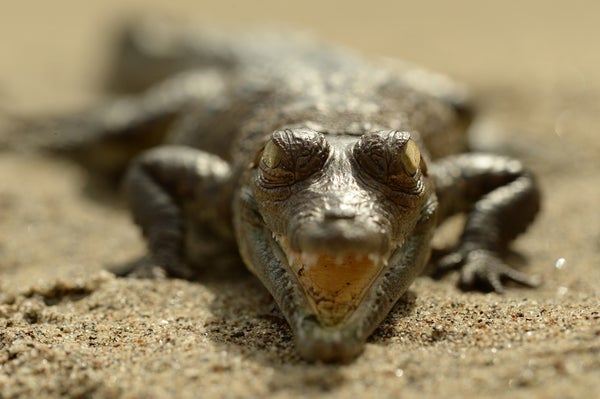This article was published in Scientific American’s former blog network and reflects the views of the author, not necessarily those of Scientific American
Does the largest predator in the Americas still have a chance at survival in the wild? Less than 100 years ago an estimated 3 million Orinoco crocodiles (Crocodylus intermedius) roamed the river basins between Colombia and Venezuela. Today their wild population is estimated at a tiny fraction of that amount, somewhere between 250 and 1,500 animals.
A new project hopes to start to turn that around. Earlier this month 20 young crocodiles were released into an area of Colombia’s El Tuparro Natural National Park that has been nicknamed “Crocodile Lagoon.” The crocs, which all carry radio transmitters, range from 83 to 109 centimeters. If they live long enough in the wild, they could eventually reach an astonishing 5 or 6 meters in length.
The newly release crocodiles join 21 other captive-bred members of their species that conservationists released there nine months ago. Ten conservation organizations have partnered together for this effort, which is being led by Colombia’s Fundación Palmarito Casanare.
On supporting science journalism
If you're enjoying this article, consider supporting our award-winning journalism by subscribing. By purchasing a subscription you are helping to ensure the future of impactful stories about the discoveries and ideas shaping our world today.
All of this follows a very limited release of Orinoco crocodiles to another Colombian park in 2013. Crocodile researcher Maria Cristina Ardila-Robayo, an associate professor of biology at Universidad Nacional de Colombia, told me that year that transmitters mounted behind the crocodiles' heads help researchers to collect data on the animals' habitat preferences, how they behaved in the wild and the amount of territory they need in order to thrive.
That’s important because until now there really haven’t been enough Orinoco crocodiles in the wild to study their ecological needs. They nearly disappeared in the second quarter of the 20th century, after Venezuelan fur traders saw a new source of profits in the crocodiles' beautiful skins. Despite their intimidating size, the animals made easy prey for hunters. As many as 3,000 to 4,000 skins traveled out of the country every single day from 1931 to 1934. At that rate it didn't take long to nearly wipe out the species.
Even though Orinoco crocodiles have been legally protected in Colombia since the 1970s, the population has never recovered. Their numbers continued to shrink and fragmentize as their river habitats become polluted and commercialized, Ardila-Robayo told me. In addition, crocodiles are killed when they come into conflict with humans. Illegal hunting also takes a toll, and some people still eat the crocodiles' eggs, mistakenly believing the act will improve their general health or sexuality.
But like most crocodilians, the Orinoco actually breeds quite well in captivity. Universidad Nacional de Colombia has maintained a captive population since the 1970s and started successfully breeding the animals in 1991. As of 2013 the university had more than 500 crocodiles in its breeding center.
Some of those crocs are now finally living in the wild, where it’s hoped they will thrive. According to the Wildlife Conservation Society, which aided in this month’s release, Crocodile Lagoon contains plenty of fish for the park’s hungry new residents. It also already has a healthy population of other predators, including jaguars, pumas and river otters, as well as large mammals such as tapirs.
Perhaps most importantly, it’s located right across the river from an air force base, which not only provides protection to the park but also enables easy access for researchers to monitor the newly release crocodiles.
Obviously the Orinoco crocodile has a long road ahead before it can recover from the slaughter of the previous century, but this remains a welcome step toward the return of a magnificent predator and perhaps the ecosystems that will support it for centuries to come.
Previously in Extinction Countdown:
